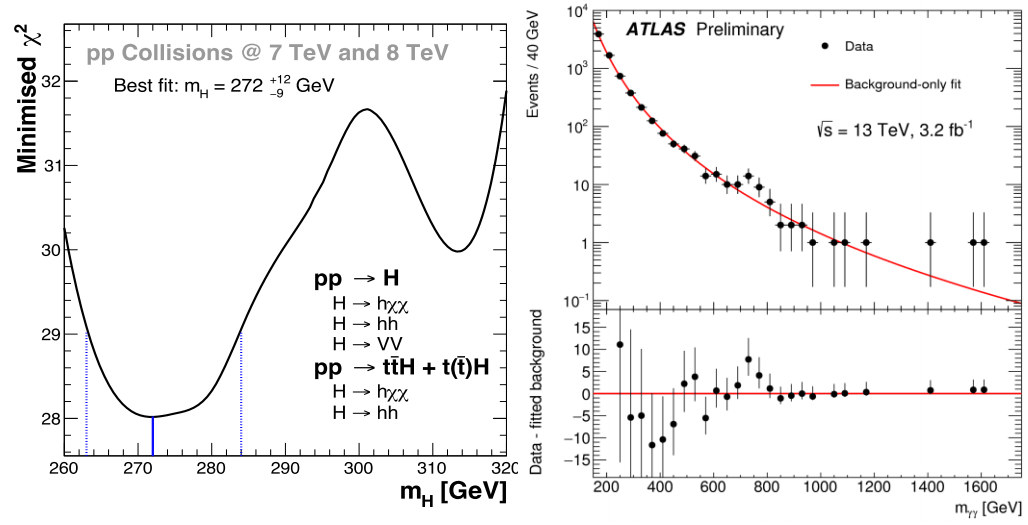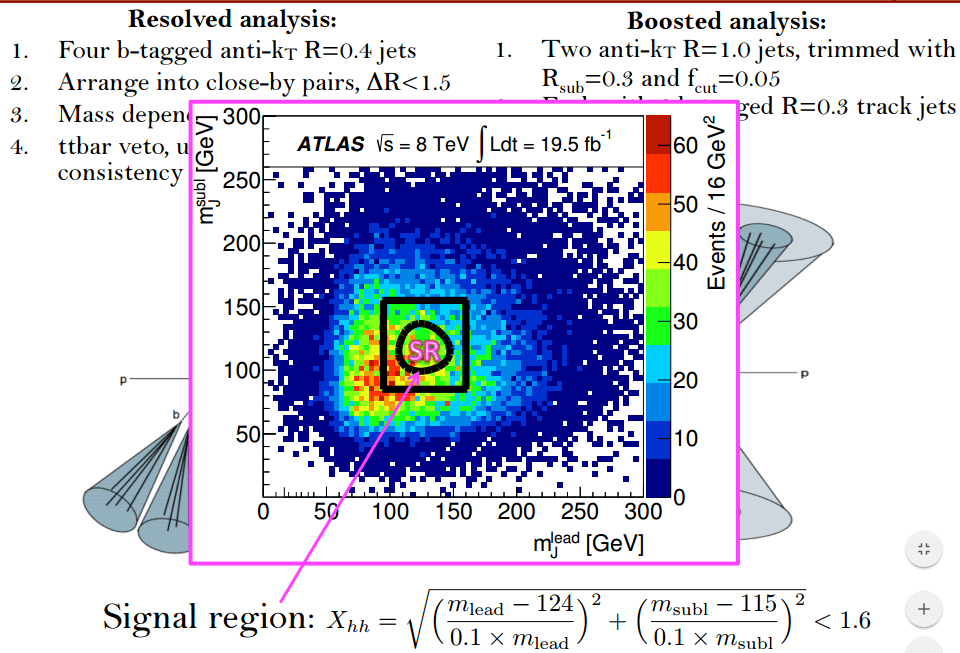Physicists from South Africa caught signs of a heavy boson Madal, which interacts with ordinary and dark matter

Signs of heavy bosons weighing about 270 and 750 GeV according to the results of processing experimental data from ATLAS and CERN. Illustration from the annual report of the South African group CERN for 2015-2016 (p. 22)
Two separate experiments on the ATLAS detector and the compact muon solenoid (CMS) at the Large Hadron Collider at CERN suggest that a new elementary particle of about 270 GeV will exist. According to the calculations of theoretical physicists from the Republic of South Africa, India and Sweden, for a new boson, the standard deviation from the expectation in absolute value does not exceed three sigma, i.e. the probability of hitting the next actual value in the confidence interval is 99.7%.

Visualization of a real experiment on the collision of two protons and two high-energy muons in a compact muon solenoid. Illustration: Taylor L / McCauley T / CERN
A new elementary particle is proposed to be called Madala boson: “Madala” is translated from Zulu as “old”.
')
If its existence is confirmed, this particle will bring us closer to unraveling one of the greatest mysteries of the Universe - what is dark matter. Madala may become the first known particle that is able to interact with dark matter.

Identification of the Higgs boson according to data obtained from the ATLAS detector. An illustration from the scientific article " Search for Higgs boson pair production at the bb¯bb ¯ = 8 TeV with the ATLAS detector " / ATLAS Collaboration
Madala is very different from the Higgs boson, discovered in 2012 at the same LHC. Madala is heavier, with its decay, the Higgs boson is formed. But the most important thing is that Madala, in theory, interacts with dark matter.
“Madala is important for our understanding of the universe. Through it, we can establish contact with dark matter, ” explains Professor Bruce Mellado of the School of Physics of the University of Witwatersrand (South Africa), lead author of the scientific work. - Until now, we did not have an object capable of such. This may be the first such object. ”
How did the scientists conclude that Madala communicates with dark matter? Very simple. Since dark matter is a synonym for “something incomprehensible”, the incomprehensible energy of a boson can be explained only by contact with dark matter. This is a rude but very logical explanation.
“Something incomprehensible” (an indefinite type of matter, ie, non-barion dark matter) makes up approximately 26.8% of the calculated mass of the Universe . It does not participate in the strong and electromagnetic interaction, and is observed only in gravitational effects. Although no one knows what it is, it must exist to comply with the physical laws in their modern version. And this “something” is very large: for comparison, ordinary baryonic matter makes up only 4.9% of the mass of the Universe .

The scientist works inside the ATLAS cryostat. Photo: Claudia Marcelloni / CERN
To test the theory of the Madal boson, the participants of the ATLAS and CMS collaborations have just published the results of experiments in which African scientists confirmed the signs of a new elementary particle with an error of three sigma. These experiments were conducted in 2015 and 2016 to confirm the patterns (Madal's hypothesis) found in the experimental data of Run I, that is, before the closing of the LHC for two and a half years at the end of 2012. New experimental data confirmed the hypothesis of Madal with high confidence. The Madala project has been engaged for several years by the High Energy Physics Group (HEP) of 35 young students and researchers from South Africa and other African countries, assisted by physicists from the University of Witwatersrand, as well as colleagues from India and Sweden.
The publication of new experimental data from ATLAS and CMS was held at the 38th International Conference on High Energy Physics ICHEP2016 , which takes place in Chicago from August 3 to 10, 2016.
Professor Mellado says dark matter is a new frontier of modern physics. Scientists all over the world are competing in whoever will be able to understand what it is. China and Japan have announced plans to build their own colliders, which will help determine the essence of dark matter and dark energy.
The Madala boson will help to supplement or replace the Standard Model - a theoretical construct in particle physics, describing the electromagnetic, weak, and strong interaction of all elementary particles. The discovery of the Higgs boson helped to fill the gap in the Standard Model, but it is still unable to explain a number of other phenomena, including the existence of dark matter and gravity.
“Modern physics is at a crossroads. The situation is similar to the times of Einstein and the fathers of quantum mechanics, says Bruce Mellado. - Classical physics could not explain a number of phenomena. As a result, revolutionary new concepts, such as relativity and quantum physics, were required, which led to the formation of modern physics as we know it. ”
The discovery of Madala and other heavy W-bosons will be evidence of the existence of forces and particles, which were not previously known. Confirmation of these discoveries will be the basis for the formulation of new fundamental physical theories.
It should be noted that in mid-2015, physicists from the Hungarian Academy of Sciences also announced the discovery of another new boson weighing 17 MeV (32.7 times heavier than an electron), according to the results of the BAK experiments, and the possible discovery of the fifth fundamental interaction. Theoretically, this boson can also interact with dark matter. The discovery of Hungarian scientists remained unnoticed until 2016, when these calculations were confirmed by theoretical physicists from the University of California, Irvine .
CERN South African Group Annual Report 2015-2016 For information on new heavy bosons, see pp. 22-23
Source: https://habr.com/ru/post/397279/
All Articles